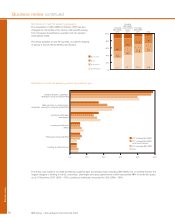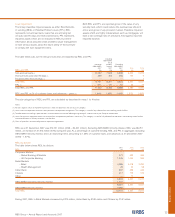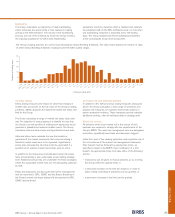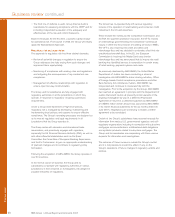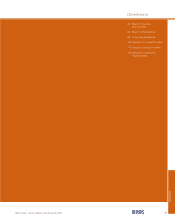RBS 2007 Annual Report Download - page 87
Download and view the complete annual report
Please find page 87 of the 2007 RBS annual report below. You can navigate through the pages in the report by either clicking on the pages listed below, or by using the keyword search tool below to find specific information within the annual report.
Business review
85
RBS Group • Annual Report and Accounts 2007
0
5
10
15
20
25
< (20)
(20) > < (18)
(18) > < (16)
(16) > < (14)
(14) > < (12)
(12) > < (10)
(10) > < (8)
(8) > < (6)
(6) > < (4)
(4) > < (2)
(2) > < 0
0 > < 2
2 > < 4
4 > < 6
6 > < 8
8 > < 10
10 > < 12
12 > < 14
14 > < 16
16 > < 18
18 > < 20
20 > < 22
22 > < 24
24 > < 26
26 > < 28
28 > < 30
30 > < 32
32 > < 34
34 > < 36
36 > < 38
> 38
Number of trading days
Trading income (£m)
The Group’s trading activities are carried out principally by Global Banking & Markets. The chart below depicts the number of days
on which Global Banking & Markets’ trading income fell within stated ranges.
Backtesting
The Group undertakes a programme of daily backtesting,
which compares the actual profit or loss realised in trading
activity to the VaR estimation. The results of the backtesting
process are one of the methods by which the Group monitors
the ongoing suitability of its VaR model. Backtesting
exceptions are those instances when a realised loss exceeds
the predicted VaR. At the 99% confidence level, no more than
one backtesting exception is expected every 100 trading
days. The Group experienced three backtesting exceptions
at the consolidated Group level during 2007.
(ii) Stress testing
Stress testing measures the impact of abnormal changes in
market rates and prices on the fair value of the Group’s trading
portfolios. GEMC approves the high-level market risk stress test
limit for the Group.
The Group calculates a range of market risk stress tests each
day. The objective of stress testing is to identify the loss that
the Group’s current portfolio of trading book exposures would
generate in plausible but adverse market events. The Group
calculates historical stress tests and hypothetical stress tests.
Historical stress tests calculate the loss that would be
generated if the market movements that occurred during a
historical market event were to be repeated. Hypothetical
stress tests calculate the loss that would be generated if a
specific set of adverse market movements were to occur.
In addition to the Group-level consolidated market risk stress
tests, stress testing is also undertaken at key trading strategy
level. Additional stress tests are undertaken for those strategies
where the associated market risks are not adequately captured
by VaR.
Stress test exposures are discussed with senior management
and are reported to GRC, GEMC and the Board. Breaches in
the Group’s market risk stress testing limit are reported to GRC,
GEMC and the Board.
(iii) Position risk and sensitivity analyses
In addition to the VaR and stress testing measures discussed
above, the Group calculates a wide range of sensitivity and
position risk measures, for example interest rate ladders or
option revaluation matrices. These measures provide valuable
additional controls, often at individual desk or strategy level.
Market risk controls
All divisions which incur market risk in the course of their
business are required to comply with the requirements of the
Group’s MRPS. The main risk management tools are delegated
authorities, specifically hard limits and discussion triggers.
Limits form part of the dealing authorities and constitute one of
the cornerstones of the market risk management framework.
Their breach must be followed by appropriate action, as
specified in detail in the MRPS. Upon notification of a limit
breach, the appropriate body must take either of the following
actions:
•instructions can be given to reduce positions so as to bring
the Group within the agreed limits, or
•a temporary increase in the limit (for instance, in order to
allow orderly unwinding of positions) can be granted, or
•a permanent increase in the limit can be granted.



